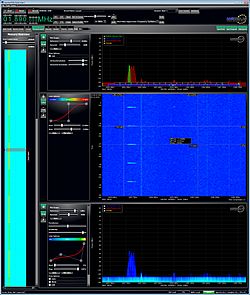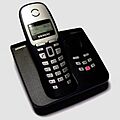DECT facts for kids
| Digital enhanced cordless telecommunications | |

Gigaset A165 phone with base station. In DECT terminology, the phone is the 'portable part' (PP) and the base station the 'fixed part' (FP).
|
|
| Abbreviation | DECT |
|---|---|
| Organization | ETSI, DECT Forum |
| Domain | Cordless telephony |
Digital Enhanced Cordless Telecommunications (DECT) is a special way for cordless phones to talk to each other. It's like a secret language for your home phone! This standard was created in Europe. It replaced older systems there.
DECT is now used in many parts of the world. This includes Australia, Asia, and South America. In North America (like the United States and Canada), a special version called DECT 6.0 is used. It uses slightly different radio frequencies. This means a DECT 6.0 phone won't work with a DECT system from Europe.
DECT was first made for phones that could move between different base stations. But it became super popular for cordless phones in homes. It's also used in small offices. You can find DECT in bigger business phone systems too. Besides phones, DECT is used for things like baby monitors and wireless microphones. There's even a version called DECT ULE for smart home devices.
Most DECT phones and base stations can work together. This is thanks to something called the Generic Access Profile (GAP). It lets you use a phone from one company with a base station from another. Japan has its own DECT version called J-DECT.
Newer DECT standards, like NG-DECT (also called CAT-iq), offer more features. These include clearer sound for calls. They also make it easier for different brands of phones to work together. A very new standard, DECT-2020 New Radio (NR+), is for fast data and smart devices. It can even work alongside older DECT devices.
Contents
How DECT Started
The DECT standard was created by a group called ETSI. They started working on it in the late 1980s. The first rules for DECT were published in the early 1990s.
At first, it was called "Digital European Cordless Telephone." Later, its name changed to "Digital European Cordless Telecommunications." This was because it could do more than just phone calls. In 1995, "European" was changed to "Enhanced." This showed that it was used all over the world. The ITU (a global telecom group) even recognized DECT as a type of 3G system.
The main DECT frequency band is 1880–1900 MHz. This is used in Europe and many other places. In the United States, the Federal Communications Commission (FCC) approved a nearby band in 2005. This band is 1920–1930 MHz. It's known as Unlicensed Personal Communications Services (UPCS). This allowed DECT devices to be sold in the U.S. with small changes. These channels are mostly for voice calls. This means less interference from other wireless gadgets.
The NG-DECT standard came out in 2007. It was made to help DECT work better with internet-based phone systems (VoIP). It brought features like wideband audio. This makes voices sound much clearer.
DECT Ultra Low Energy (DECT ULE) was introduced in 2011. It's designed for smart home devices that use batteries. These include security sensors and energy monitors. DECT ULE uses the 1.9 GHz band. This helps it avoid interference from things like microwave ovens. Other wireless tech like Zigbee and Bluetooth use the 2.4 GHz band, which microwaves also use.
A new audio codec called LC3plus was added to DECT in 2019. This helps with high-quality sound for wireless speakers and headphones.
The DECT-2020 New Radio protocol was released in 2020. It's a big step forward for DECT. It allows for very fast data transfer. It also supports new features like MIMO (using multiple antennas). This new protocol is great for industrial automation and professional wireless audio. It's marketed as NR+.
What DECT is Used For
DECT was planned for a few main uses:
- Home cordless phones: Connecting one or more cordless phones to your home phone line. This has been very successful.
- Business phone systems: Using many base stations in offices. This allows calls to continue as people move around. This has also been very successful.
- Public access: Providing phone service in public areas. This idea didn't really take off. Mobile phone networks became much more popular.
DECT has also been used in some countries to provide phone service to homes. This was in places where regular phone lines were hard to install. It acted as a "wireless local loop."
Early on, DECT was even used for wireless internet. One of the first DECT products was a wireless network called Net3. It was like an early version of Wi-Fi. But Wi-Fi and mobile data (3G, 4G) became much more popular.
How DECT Works
DECT helps a cordless phone (the "Portable Part") connect to a phone network. It does this using radio waves. A "Fixed Part" or base station handles the radio connection. This base station then links to your home phone line or office system.
A typical home DECT system lets you have several cordless phones. They all share one phone line. You can place these phones around your house. Extra phones usually just need a charger. Many DECT phones can also be used like an intercom. They can talk to each other without using the phone line.
DECT uses radio frequencies between 1880 and 1900 MHz in Europe. It divides the radio space in two ways: by frequency and by time. This means it uses different channels and different time slots. This allows many calls to happen at once.
DECT is good at avoiding interference. It usually works well even with other wireless devices nearby. This includes Wi-Fi, Bluetooth, and baby monitors.
Technical Details
DECT uses special ways to turn your voice into digital signals. It uses something called ADPCM for regular calls. For clearer, "wideband" calls, it uses G.722.
The power of a DECT phone is usually around 10 milliwatts (mW) on average. But it can send out short bursts of up to 250 mW. This is why DECT phones can work well up to about 100 meters (about 330 feet) outdoors. Inside, walls can reduce the range.
DECT phones are smart about choosing channels. If a channel has too much interference, the phone can switch to a clearer one. This helps keep your calls clear.
Security in DECT
DECT has security features to protect your calls. It uses a special code to make sure your phone is really talking to your base station. This is called authentication. When you register a new phone, they share a secret key.
DECT also offers encryption. This scrambles your voice so others can't easily listen in. Older DECT systems had some weaknesses in their encryption. Experts found ways to listen to calls if the encryption wasn't used properly.
However, newer DECT standards have improved security. They use stronger encryption methods, like AES 128-bit encryption. There's also a DECT Security certification program. This makes sure phones use these better security features.
Special DECT Versions
DECT 6.0
"DECT 6.0" is a marketing name for DECT phones sold in North America. These phones use the 1.9 GHz frequency band. The "6.0" doesn't mean it's a faster or newer version. It was just a way to make it sound more advanced than older 2.4 GHz or 5.8 GHz cordless phones.
DECT 6.0 phones in North America have some differences. They use a slightly smaller frequency band. Their average power is 4 mW, which is less than the 10 mW in Europe. This can mean a shorter range. Also, phones from different brands in the U.S. might not always work together as easily as in Europe.
It's important to know that DECT 6.0 phones from North America should not be used in Europe or other regions. They can interfere with local mobile phone networks. The same goes for European DECT phones in North America.
"DECT 8.0 HD" is another marketing term. It means a North American DECT phone supports the CAT-iq 2.0 "Multi Line" features.
NG-DECT/CAT-iq
CAT-iq stands for "Cordless Advanced Technology—internet and quality." It's a program that certifies DECT devices. It's based on the New Generation DECT (NG-DECT) standards.
CAT-iq adds many advanced features to DECT phones. These include:
- HD Voice: This means much clearer sound for calls.
- Multiple lines: You can manage several phone lines on one handset.
- Enhanced security: Better protection for your calls.
- Smart home features: Connecting with DECT ULE devices.
CAT-iq helps different brands of DECT phones and base stations work together better. This is especially useful for phones that connect through the internet (VoIP).
DECT-2020
DECT-2020, also known as NR+, is a very new DECT standard. It's designed to meet some of the requirements for 5G technology. It's perfect for the "Internet of Things" (IoT). This means connecting many smart devices together.
DECT-2020 NR has new abilities:
- It works better when there are many radio signals around.
- It has better radio sensitivity, meaning it can pick up weaker signals.
- It's more resistant to interference.
- It uses the radio space more efficiently.
- Devices can connect directly to each other in a "mesh network."
This new standard is designed to work alongside older DECT devices. It checks for clear channels to avoid causing problems.
Health and Safety
DECT uses radio waves, just like mobile phones, Wi-Fi, and baby monitors. These are called Ultra High Frequency (UHF) radio waves.
In North America, DECT phones use less power (4 mW average) than in Europe (10 mW average). This means they have a shorter range.
Some studies have looked at whether radio waves from phones affect health. Most studies haven't found a clear link to health problems. The World Health Organization says that more research is needed on long-term effects.
Images for kids
See also
 In Spanish: Digital Enhanced Cordless Telecommunications para niños
In Spanish: Digital Enhanced Cordless Telecommunications para niños




